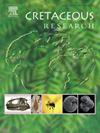Paleoenvironmental changes in the western Tethys carbonate platforms during OAE-2: Implications from phosphorus, δ18O, δ13C and facies analysis
IF 1.9
3区 地球科学
Q1 GEOLOGY
引用次数: 0
Abstract
Oceanic anoxic event 2 (OAE-2) is one of the largest paleoclimatic events of the whole Phanerozoic which occurred at the Cenomanian/Turonian Boundary (CTB). It caused major perturbation of the C-cycle at global scale together with changes in other geochemical cycles. OAE-2 severely impacted marine and terrestrial settings causing faunal turnovers both in pelagic and neritic environments. The exact mechanisms triggering OAE-2 are debated but it is believed that the main driver was a massive injections of volcanic CO2 in the atmosphere. The effect of OAE-2 on deep-water communities has been extensively documented in literature. In contrast, less data are available for their shallow-waters counterparts. Geochemical and semiquantitative facies analysis on samples from two carbonate platforms located in Italy (former western Tethys) are presented in this paper, where new data from the Friuli-Adriatic Carbonate Platform are compared with a well-known section from the Apennine Carbonate Platform. Our data show a good correlation between these platforms, located 1000 km apart. Phosphorus concentrations are low except for two intervals: (1) at the onset of the OAE-2 and (2) in the late phase of the event. The δ18O record shows an increase of the Sea Surface Temperature (SST) during the event interrupted by a cooler interval. Our data indicate a correlation between geochemical changes and faunal turnover of benthic foraminifera and rudists, suggesting the co-occurrences of several causes for the demise of these groups during OAE-2.
求助全文
约1分钟内获得全文
求助全文
来源期刊

Cretaceous Research
地学-地质学
CiteScore
4.10
自引率
19.00%
发文量
235
审稿时长
12 weeks
期刊介绍:
Cretaceous Research provides a forum for the rapid publication of research on all aspects of the Cretaceous Period, including its boundaries with the Jurassic and Palaeogene. Authoritative papers reporting detailed investigations of Cretaceous stratigraphy and palaeontology, studies of regional geology, and reviews of recently published books are complemented by short communications of significant new findings.
Papers submitted to Cretaceous Research should place the research in a broad context, with emphasis placed towards our better understanding of the Cretaceous, that are therefore of interest to the diverse, international readership of the journal. Full length papers that focus solely on a local theme or area will not be accepted for publication; authors of short communications are encouraged to discuss how their findings are of relevance to the Cretaceous on a broad scale.
Research Areas include:
• Regional geology
• Stratigraphy and palaeontology
• Palaeobiology
• Palaeobiogeography
• Palaeoceanography
• Palaeoclimatology
• Evolutionary Palaeoecology
• Geochronology
• Global events.
 求助内容:
求助内容: 应助结果提醒方式:
应助结果提醒方式:


